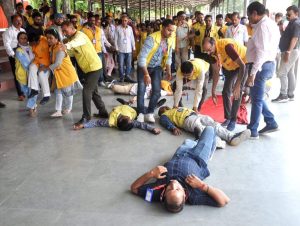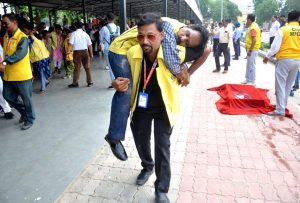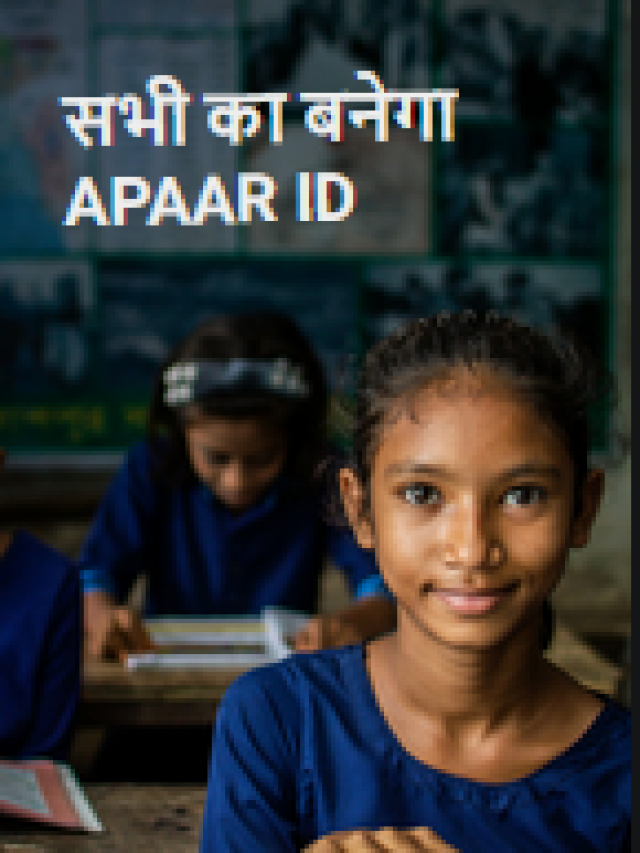Nationwide Blackout Drill in India: What You Need to Know
Introduction: The Importance of Preparedness in Civil Defense
Preparedness remains a cornerstone of resilience during emergencies, particularly in densely populated regions like India, where unforeseen events can have widespread implications. Civil defense, as a structured approach to mitigating risks and ensuring public safety, relies heavily on anticipatory measures. This approach is vital for minimizing the impact of natural disasters, infrastructure failures, or large-scale emergencies such as nationwide blackouts. By fostering readiness, communities build the capacity to respond effectively while protecting lives and infrastructure.
India rapid urbanization and reliance on interconnected systems heighten the potential consequences of disruptions in essential services. A nationwide blackout, though hypothetical, represents one such scenario that could paralyze cities, disrupt communication networks, and pose significant risks to healthcare facilities. Without deliberate preparation, even minor delays in response measures could lead to cascading failures across various sectors, revealing gaps in infrastructure and coordination.
Drills and simulations play a central role in civil defense by providing a controlled environment for testing response protocols and inter-agency coordination. Such exercises allow authorities to identify vulnerabilities, train personnel, and educate the public on appropriate actions during crises. India’s emphasis on strengthening its preparedness through initiatives like a nationwide blackout drill underscores the importance of proactive measures.
Preparedness is not the sole responsibility of government agencies; it requires collective efforts involving civilians, local authorities, and private sectors. By fostering this synergy and encouraging public awareness, nations can mitigate risks and recover more efficiently from disasters. Addressing weaknesses through structured activities such as blackout drills ensures that systems are not only reactive but robust enough to anticipate and endure challenges.

Understanding India’s Nationwide Blackout Drill
A nationwide blackout drill in India represents a strategic and coordinated event aimed at testing the nations resilience to power outages while ensuring preparedness for unforeseen crises. Such drills are initiated by government bodies in collaboration with national and regional electricity authorities, emergency services, and other critical infrastructure stakeholders. The primary objective is to simulate large-scale disruptions in electricity supply to evaluate the effectiveness of contingency plans, detect vulnerabilities, and enhance communication between key players.
The drill generally involves a phased approach, ensuring disruption is controlled and minimal. Authorities isolate specific regions to temporarily suspend power under predetermined scenarios. This process ensures that real-time stress tests are conducted on regional power grids without permanently affecting essential services or public safety. Various stakeholders, including hospitals, manufacturing units, public transportation systems, and communication networks, are notified in advance to mitigate risks or disruptions to critical services.
Key components of the exercise include assessing the reliability of backup systems, testing synchronization protocols for grid restoration, and gauging the emergency response from energy agencies. Stakeholders are often provided a checklist, ensuring their readiness to deploy generators, maintain fuel reserves, and secure uninterrupted IT operations.
Government reports suggest these drills also emphasize public participation through advisory notices. Residents are encouraged to conserve energy and stay informed to minimize the impact of localized blackouts. Collaboration with disaster management agencies amplifies the effectiveness of such exercises.
Through simulations of cross-sectoral disruptions, authorities gain insight into India’s power infrastructure’s adaptability. Feedback gathered post-drill helps identify weak points and guide the implementation of upgraded policies and technologies. This reinforces public trust, ensuring sustainability and reliability in energy supply systems for a growing nation.
Historical Context: Lessons from Past Blackouts and Crises

The nationwide blackout drill in India serves as a significant response to lessons learned from national and international experiences of power crises. Historically, blackouts have underscored vulnerabilities in electrical grids, supply chains, and contingency planning. One notable example is the 2012 India blackout, one of the largest in history, where over 620 million people were affected due to grid failures. It exposed critical issues in infrastructure and inter-regional power transfer protocols.
Globally, examples like the 2003 Northeast blackout, which affected parts of the United States and Canada, offer valuable insights. The incident highlighted how cascading failures in power grids can lead to widespread disruptions. It was traced back to inadequate tree trimming near power lines, emphasizing the need for consistent maintenance and monitoring. Similarly, extreme weather events like hurricanes in the United States, such as Hurricane Katrina in 2005, have revealed deficiencies in disaster-readiness linked to power restoration and emergency supply provisions.
Crises in other sectors reinforce the value of preparedness. The COVID-19 pandemic highlighted the importance of robust logistical frameworks to address sudden surges in demand for essential utilities. Such events underline the necessity of stress tests and drills to identify weak points in critical infrastructure before real emergencies. Systems evolve through lessons derived from these episodes, enabling countries to implement design improvements and operational reforms.
India’s recent initiatives reflect an acknowledgment of these historical lessons. Incorporating advanced technologies, decentralized energy systems, and coordinated emergency protocols into its current preparatory measures demonstrates a proactive approach aimed at avoiding past missteps.
Objectives Behind the Blackout Drill Initiative
The nationwide blackout drill in India has been designed with specific and systematic objectives to ensure preparedness in the event of unforeseen emergencies. The initiative focuses on strengthening the nations ability to respond effectively to large-scale power outages, maintaining societal stability, and safeguarding critical infrastructure.
One of the primary objectives of this exercise is to enhance national readiness for power loss scenarios. From natural disasters such as cyclones and earthquakes to man-made threats like cyberattacks or sabotage, unexpected events can cause significant disruptions to the power grid. Conducting such a drill allows authorities to evaluate risk factors and test existing contingency plans under simulated but controlled conditions.
Another key aim is to test the resilience of emergency services and backup power systems. Hospitals, transportation networks, data centers, and utilities rely on uninterrupted power supply to function effectively. The drill helps identify vulnerabilities in alternate power mechanisms, including generators and stored energy systems, ensuring that essential services remain operational during blackouts.
The exercise also seeks to improve inter-agency coordination. Effective response to a nationwide blackout requires joint efforts across multiple stakeholders, including the power ministry, disaster management agencies, armed forces, and local governments. The drill provides an opportunity to streamline communication channels, clearly define roles, and eliminate inefficiencies.
Additionally, the initiative aims to educate citizens about preparedness measures. Public awareness campaigns and community participation during the drill encourage individuals and businesses to adopt proactive steps, such as stocking essential supplies and securing home power backups.
By focusing on these objectives, the blackout drill ensures that both governmental and civilian systems are better equipped to mitigate disruptions and adapt to challenges arising from prolonged power failures.
Role of Government Agencies in Coordinating the Drill
The success of a nationwide blackout drill relies heavily on the coordinated efforts of government agencies at multiple levels. Key departments and institutions are entrusted with responsibilities to ensure the drill runs seamlessly while achieving its intended objectives. Their roles are multifaceted, ranging from planning and preparation to execution and post-drill evaluation.
Planning and Preparation
Government agencies such as the Ministry of Power, the National Disaster Management Authority (NDMA), and state-level disaster management departments are responsible for outlining the framework of the drill. These agencies develop detailed action plans, allocate resources, and define protocols for the blackout simulation. Collaboration with local governments, industry stakeholders, and community organizations ensures cohesive execution across diverse geographical regions.
Logistics and Coordination
The drill demands meticulous logistical planning. Agencies coordinate the shutdown and restoration of power supply in phases, ensuring minimal disruption to critical infrastructure. The Central Electricity Authority (CEA), in collaboration with state electricity boards, oversees precise synchronization of activities across all power grids. Communication systems are established, enabling real-time updates and emergency instructions during the event.
Public Awareness and Information Dissemination
Government agencies play a pivotal role in disseminating information to the public before and during the drill. Departments such as the Ministry of Information & Broadcasting ensure citizens are aware of the purpose and schedule of the blackout exercise. Public advisories and media campaigns help mitigate panic and prepare communities to adapt to temporary power outages.
Monitoring and Safety Assurance
Agencies including the NDMA and local emergency response teams monitor the drill to identify and address potential risks. Measures are planned to safeguard essential services such as hospitals, transportation networks, telecommunications, and water supply systems. Safety protocols are strictly enforced, ensuring the drill doesn’t compromise lives or property.
Evaluation and Reporting
Post-drill, government agencies assess the execution and efficacy of the exercise. The data collected is analyzed to identify gaps and improve future preparedness strategies. Reports detailing successes and challenges are shared with stakeholders, aiding in national energy resilience initiatives and enhancing disaster readiness efforts.
By fulfilling these responsibilities, government agencies ensure that a nationwide blackout drill is not only a learning experience but also an opportunity for strengthening systems and public preparedness.
Engaging Communities: Public Awareness and Participation
Public awareness and community participation are critical for the success of nationwide initiatives such as blackout drills. To ensure widespread understanding and preparedness, authorities must implement multi-faceted communication strategies tailored to address diverse segments of the population. Effective engagement begins with a clear dissemination of objectives, timelines, and guidelines, employing tools that resonate with citizens across regions.
Local governments, media outlets, and citizen groups play a pivotal role in spreading awareness. Key information is often shared through public service announcements, traditional channels like newspapers and radio, and modern digital media platforms, including social networks, government websites, and mobile apps. Posters, flyers, and pamphlets distributed in public spaces also help to ensure a broad reach, particularly in rural or underserved areas where internet penetration may be limited.
To foster active participation, authorities organize workshops, town hall meetings, and training sessions designed to educate communities on the importance of preparedness. Many initiatives include simulation exercises, allowing residents to rehearse their roles during blackouts, such as managing emergency supplies, navigating power outages safely, and communicating effectively during disruptions. These activities are tailored to age groups or specific professions, ensuring inclusivity in knowledge dissemination.
Feedback mechanisms also enhance engagement. Suggestion boxes, helpline numbers, and online surveys allow residents to voice concerns and provide input on the drills organization. Collaboration with schools, NGOs, and local businesses can amplify the initiatives impact by leveraging their networks and resources.
Regular updates and reminders contribute to community readiness as the drill date approaches. By highlighting the collective benefits of participation, such as enhanced safety and infrastructure resilience, authorities can instill a sense of shared accountability and commitment, thereby ensuring the drills success at a grassroots level.
Technical Challenges of Conducting a Nationwide Blackout Drill
Executing a nationwide blackout drill encompasses a series of intricate technical challenges, given the scale, complexity, and interdependent nature of power grids. The foremost challenge lies in coordinating the operation across multiple regions, each with distinct electricity demand patterns, grid infrastructures, and climatic conditions. Ensuring synchronization while managing these variables requires precise planning and real-time communication between grid operators, state load dispatch centers, and central control units.
Another significant issue emerges from the inherent instability of power grids during shutdowns and restarts. A sudden drop in load can result in frequency fluctuations, risking damage to sensitive equipment and cascading failures. Controlled power shutdown and restoration, therefore, demand sophisticated simulation tools and contingency planning. Grid islanding, the process of segmenting the grid into smaller units, needs to be carefully executed to minimize disruption.
The integration of renewable energy sources such as solar and wind introduces additional technical constraints. Their variable output can complicate the power restoration process, as fluctuating inputs might prevent operators from achieving the required grid stability. Backup systems and storage mechanisms, such as battery systems, need to be effectively synchronized with the grid for support.
Testing of communication systems becomes equally critical during such drills. Reliable data exchange between different power stations, substations, and operational teams is foundational for the exercise. Outdated technologies or incompatible communication protocols can hinder this process, leading to inefficiencies.
Further, cybersecurity risks escalate during blackout drills. Malicious actors might exploit vulnerabilities during system resets or grid adjustments. Preventive countermeasures, including real-time monitoring and advanced intrusion detection systems, are essential.
Finally, ensuring continuity of critical services like hospitals, transportation, and water supply requires manual interventions and additional safeguards. Balancing the needs of these essential services while implementing the blackout poses logistical hurdles that demand strategic foresight.
Simulated Scenarios: What Does the Drill Entail?
The nationwide blackout drill in India involves a series of meticulously planned simulated scenarios to test preparedness and identify vulnerabilities in the power grid, emergency response, and related infrastructures. These simulations aim to mimic real-world conditions to ensure systems and personnel can operate effectively under stress or during a catastrophic failure.
Key components of the simulation include:
Power Grid Disruption: The drill simulates a complete or partial shutdown of the national power grid, accounting for cascading failures or multiple points of disruption. This ensures authorities can test response protocols for large-scale energy shortages.
Communication Breakdowns: The scenarios include simulated failures in communication channels, such as telecommunication networks, internet services, and mobile infrastructure, to prepare authorities for potential information blackouts.
Transportation Challenges: Authorities assess how a blackout would affect transportation systems, including railway operations, traffic signals, and airport facilities, to determine contingency plans.
Healthcare System Readiness: Scenarios test hospitals’ ability to continue operations using backup systems like generators. The focus is on ensuring critical services, such as life-support machinery, remain uninterrupted.
Supply Chain Management: The drill evaluates how a blackout impacts supply chains for essential commodities, such as water, food, and fuel, ensuring alternative distribution methods can be implemented swiftly.
Public Safety and Order: Authorities observe the effects on surveillance systems, law enforcement operations, and disaster response activities, gauging how to maintain control and safety during prolonged disruptions.
Participants in the drill include power grid operators, emergency services, law enforcement agencies, government officials, and private sector stakeholders. The collaborative approach ensures all roles in the ecosystem are tested. Each team receives pre-designed scenarios intended to replicate various challenges, such as cyberattacks or natural disasters, to simulate real-life crises effectively.
By rehearsing these simulated scenarios, authorities refine emergency measures and enhance the robustness of critical systems.
Impact on Critical Infrastructure During the Blackout Drill
The nationwide blackout drill in India poses significant challenges for critical infrastructure, necessitating careful planning and coordination to mitigate risks. Power grids, telecommunications, transportation systems, healthcare facilities, and water supply networks represent some of the essential services directly impacted during these simulated events. The temporary suspension of electricity serves as a stress test for identifying vulnerabilities and evaluating the resilience of these systems.
Power grids play a central role, as controlled outages test the systems’ capacity to handle fluctuations and ensure mechanisms like load shedding or emergency backups operate efficiently. Telecommunications, integral for maintaining communication during the blackout, may experience disruptions, particularly in rural regions reliant on limited infrastructure. Preventive measures, such as using backup generators and prioritizing emergency communication lines, are evaluated during the drill.
Public transportation systems, including railways and metro networks, also face disruptions due to reliance on electrical power. Authorities test protocols for evacuation, alternative routes, and crowd management to maintain operational continuity. Healthcare facilities are another critical area, with hospitals depending heavily on uninterrupted power for life-saving equipment. Backup power systems, such as diesel generators and battery reserves, are tested under real-time conditions to ensure patient safety.
Water supply and sewage systems dependent on electric pumps and treatment facilities similarly undergo scrutiny. Government and local authorities assess whether contingency measures, like water storage and alternative pumping methods, can sustain demand during prolonged outages.
The interdependency of these infrastructures makes coordination crucial. The blackout drill highlights weaknesses and prepares stakeholders ”government agencies, private operators, and the publican ”for effective response strategies. This exercise offers actionable insights necessary for fortifying India’s essential services against unforeseen emergencies.
Lessons from Other Nations Emergency Preparedness Exercises
Several nations have conducted extensive emergency preparedness exercises to simulate large-scale disruptions, providing valuable insights that can inform India’s approach to a nationwide blackout drill. These exercises emphasize the importance of robust planning, coordination, and public awareness in mitigating the effects of unforeseen crises.
United States: The Federal Emergency Management Agency (FEMA) conducts exercises like “GridEx,” which simulate cyberattacks on critical infrastructure leading to blackout scenarios. These drills underline the importance of interagency coordination, communication strategies, and public-private partnerships. The focus on protecting electrical grids from cybersecurity threats is a key takeaway.
Japan: Known for its earthquake-prone geography, Japan conducts regular disaster rehearsals incorporating blackout contingencies. Their exercises demonstrate the need for rapid response systems, energy storage solutions, and decentralized power grids. Japan’s reliance on technology to maintain communication and deliver real-time updates stands as an example for integrating modern tools in disaster preparedness.
Germany: With a highly interconnected energy network, Germany simulates power outage scenarios to test grid stability and resilience. Their efforts highlight the necessity of cross-border collaboration, energy diversification, and ensuring the availability of alternative power sources in emergencies.
Australia: Exercises in Australia stress public awareness campaigns to familiarize citizens with emergency protocols during blackouts. Effective training of local communities and setting up emergency resource hubs have proven valuable in enhancing grassroots-level resilience.
A recurring lesson from these nations is the emphasis on community preparedness, along with advanced grid infrastructure and government-citizen collaboration. These insights showcase the importance of integrating global best practices into localized drills while addressing unique regional challenges.
Evaluating the Effectiveness of the Drill: Metrics and Feedback Mechanisms
Assessing the success of a nationwide blackout drill requires a robust system of metrics and feedback mechanisms to capture data and ensure actionable insights. Key performance indicators (KPIs) are central to evaluating various dimensions of the drill, such as operational readiness, communication efficiency, and public compliance. Metrics may include the time taken to restore power and essential services, the accuracy of communication about the blackout, and the rate of participation among households and businesses.
Government authorities and emergency management agencies employ several quantitative and qualitative methods to measure the effectiveness. Quantitative indicators could include the speed of emergency response deployment, the number of reported incidents during the blackout period, and the level of preparedness observed across different regions. Qualitative assessments, on the other hand, rely on detailed surveys and feedback reports from participants, community leaders, and administrators, offering insight into operational challenges and real-time experiences.
Feedback mechanisms form the backbone of the evaluation process. Structured feedback may be gathered through online portals, telephone hotlines, and post-event town hall meetings. Stakeholders such as local governments, power companies, and emergency services are typically required to submit detailed reports on their response activities. Community feedback is also collected via questionnaires, allowing authorities to gauge public sentiment and identify areas for improvement.
To ensure a comprehensive analysis, data from varied sources—including urban and rural regions—is aggregated and reviewed. Advanced analytics tools are often employed to identify trends, areas of weakness, and critical gaps in preparedness. Transitioning from raw data to actionable recommendations entails cross-agency collaboration and iterative planning.
Potential Economic and Social Implications of the Drill
A nationwide blackout drill has the potential to create ripple effects across various sectors, requiring a thorough understanding of its economic and social implications. By simulating a power outage of significant scale, essential systems, industries, and public services may temporarily experience disruptions, even within the planned framework of the drill.
Economic Implications
Impact on Businesses For businesses, particularly those in manufacturing, technology, and service sectors, the drill could lead to operational downtimes. Companies reliant on continuous power, such as data centers or factories, may face brief financial setbacks due to halted production or service interruptions. Small and medium enterprises, which may lack access to robust backup systems, could be disproportionately affected.
Supply Chain Disruptions The drill may interrupt logistics operations due to power-dependent systems like warehouse automation, cold storage facilities, and transportation networks. While short-lived, such disruptions can cascade into delays in inventory management, order processing, and delivery schedules.
Testing Economic Resilience On a macroeconomic level, the drill serves as a stress test for national economic robustness. It provides an opportunity for stakeholders to assess weaknesses in energy and infrastructure dependency, highlighting areas requiring future investments or reforms.
Social Implications
Public Awareness and Adaptation A large-scale exercise raises public awareness of power outage scenarios, fostering preparedness at individual and community levels. However, it may also evoke confusion or concern among people unaware of the drill’s purpose and scheduling.
Effects on Public Systems Public services, particularly healthcare facilities and emergency services, may face heightened responsibilities to ensure uninterrupted functionality during the drill. Stress placed on backup generators or alternative resources could reveal vulnerabilities in contingency plans.
Community Cohesion While some households might struggle with the temporary inconvenience, the drill could encourage community collaboration. Shared preparation efforts may strengthen local networks, contributing to a culture of collective resilience in the face of adversities.
By addressing these economic and social aspects, the blackout drill offers an opportunity to identify gaps and build a more prepared nation.
The Role of Technology in Ensuring Civil Defense Readiness
In modern times, technology serves as a backbone for civil defense readiness, empowering authorities to respond effectively during emergencies such as nationwide blackouts. Advanced systems and tools are increasingly integrated into preparedness initiatives, transforming how governments and emergency services anticipate and manage crises.
One critical technology is Geographic Information Systems (GIS), which enable real-time mapping and situational awareness. By analyzing data related to population density, infrastructure vulnerabilities, and resource availability, GIS supports decision-making and resource allocation. Similarly, early-warning systems, driven by artificial intelligence (AI), predict potential scenarios and alert authorities, allowing swift preventive measures.
Communication networks play a pivotal role in ensuring coordination across agencies and the public. Satellite phones and radio systems act as reliable communication channels during blackouts when conventional networks fail. Mobile applications equipped with Emergency Alert Systems (EAS) notify citizens of risks, emergency protocols, and safe zones.
The use of the Internet of Things (IoT) has further refined monitoring capabilities. Sensors embedded in key infrastructure, like power grids and water systems, provide live updates on operational health, enabling immediate corrective action in case of disruptions. Additionally, drones are employed for aerial reconnaissance to assess damage, locate survivors, and deliver essential supplies to inaccessible areas.
Training and simulations are also enhanced by virtual reality (VR) environments. These allow civil defense teams to experience realistic crisis scenarios, fostering quicker decision-making and teamwork under pressure. Blockchain technology ensures the security of sensitive data, such as evacuation plans and resource distribution records, maintaining trust and operational efficiency.
Technological advancements continue to push the boundaries of what is achievable in civil defense, providing innovative tools to mitigate risks and safeguard public welfare effectively.
Criticism and Controversies Surrounding the Blackout Drill
The nationwide blackout drill in India has faced various criticisms and controversies, primarily due to its scale, planning, and impact. Opponents of the initiative have raised concerns about its execution and questioned whether such an exercise prioritizes visibility over pragmatic problem-solving in critical situations.
One significant criticism stems from the economic implications of the drill. Experts in the energy and industrial sectors have pointed out that temporarily shutting down operations across multiple industries, even as a precautionary exercise, can result in revenue losses, delayed operations, and higher restarting costs. Critics argue that the operative cost of such drills may outweigh their benefits, particularly in resource-heavy industries like manufacturing and transportation.
Concerns regarding public safety and misinformation have also surfaced. Such a large-scale power shutdown, even temporarily simulated, could inadvertently lead to panic among individuals unfamiliar with its purpose or scope. Additionally, critics worry that vulnerable populations—including those reliant on continuous electricity for medical devices—might suffer unintended consequences if exceptions or alternate planning are inadequately communicated.
Another aspect of controversy revolves around environmental implications. Critics claim that the sudden demand surge during power restoration could increase strain on the grid and result in higher emissions, as backup generators operated on fossil fuels are often used as a safeguard in many sectors.
Finally, questions have been raised about the transparency of decision-making. Some stakeholders, including local communities, argue they were excluded from planning discussions, leaving them underprepared for the exercise. Opposition voices highlight the necessity of comprehensive public engagement and detailed risk assessments to ensure smooth implementation that aligns with the nation’s broader crisis management strategies.
Future Roadmap: Strengthening India’s Civil Defense Systems
India’s civil defense systems require a forward-looking approach to address emerging challenges posed by natural disasters, terrorist threats, and cyberattacks. To bolster preparedness, authorities are prioritizing modernizing infrastructure, enhancing interagency coordination, and improving public awareness.
Key to the future roadmap is integrating cutting-edge technology into disaster management and response frameworks. Efforts are underway to develop advanced early warning systems leveraging artificial intelligence (AI) and machine learning (ML) algorithms for real-time risk assessment. The adoption of geospatial mapping tools, interconnected communication networks, and drone surveillance systems is expected to enhance situational awareness during crises.
Strengthening human resources remains a cornerstone of the strategy. A nationwide capacity-building initiative is being planned to train first responders, including firefighters, medical professionals, and civil defense volunteers. Regular simulation exercises in urban and rural areas alike aim to ensure timely and efficient responses. Additionally, specialized advanced training modules will address domain-specific risks, such as chemical spills or nuclear incidents.
Improving public involvement constitutes a critical aspect of this roadmap. Governments are preparing extensive outreach campaigns to educate citizens about emergency protocols. Interactive mobile applications are anticipated to help disseminate actionable guidance during disasters. Schools and workplaces could see mandatory drills to instill a culture of readiness across diverse community segments.
Policy-level advances are likely to include revising existing disaster management legislation and expanding budget allocations for civil defense. Partnerships with global agencies and private-sector entities are expected to contribute technical expertise and financial support.
The overarching vision for India’s civil defense framework focuses on fostering resilience, technological adeptness, and an inclusive approach that engages every stakeholder in fortifying the nation’s disaster response capabilities.
Conclusion: Building a Resilient and Prepared Nation
A nationwide blackout drill is more than a mere exercise; it represents a structured approach toward fostering resilience and preparedness against unforeseen crises. Such initiatives demand comprehensive coordination among government agencies, utility providers, emergency services, and, most significantly, the general public. Each participant plays a vital role in ensuring the drill’s success and in identifying potential gaps for future improvements.
These drills underline the importance of establishing robust contingency plans and communication networks. By simulating a power outage scenario on a large scale, authorities can test the efficiency of emergency protocols and resource allocation strategies. Moreover, it encourages the involvement of communities in disaster-preparedness training and fosters a sense of collective responsibility.
Key components of a successful blackout drill include:
Advanced Planning and Communication: Dissemination of clear and actionable instructions to all stakeholders ensures minimal disruption during the exercise.
Technological Integration: Deployment of simulation tools and advanced monitoring systems aids in scenario-based analysis and real-time decision-making. Feedback Mechanisms: Gathering and evaluating data from drills allows for the refinement of emergency protocols to address shortcomings.
While infrastructure resilience is bolstered, such exercises also bring attention to the vulnerabilities in healthcare systems, public transportation, water supply, and digital communications. Ensuring backup solutions in these sectors can significantly mitigate the cascading impact of a nationwide blackout.
Public participation remains integral to the success of these initiatives. Educating citizens on proper responses during a blackout, such as conserving energy or using alternative light sources safely, helps minimize panic and facilitates smoother execution.
In a world exposed to evolving risks, such proactive measures serve as stepping stones toward building a nation capable of withstanding challenges and ensuring the safety and well-being of its populace.


